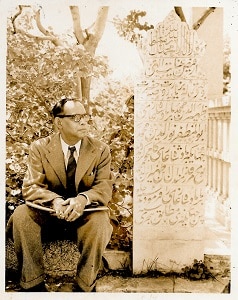
In 1946, a year before the Partition and Independence of India, I was a young seven year old girl living in Calcutta with my family. My father, a historian, Dr. Makhan Lal Roy Choudhury, had recently returned from a lecture tour in Egypt. We had moved to Calcutta from Bhagalpur in Bihar in 1942 because he had accepted a position to start up the Department of Islamic History in Calcutta University. He was also Superintendent of a hostel for graduate students of the University and was given a spacious house within the compound, where I lived with my parents and four sisters.
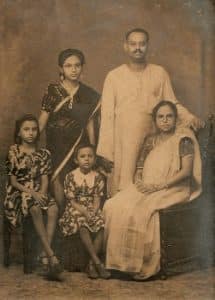
These were troubled times, filled with pre-Independence uncertainties. 1946 was a crucial year for our family and that memory brings nothing but pain. Those pre-independence days saw the relationship between Muslims and Hindus coming to a boil, the communities becoming more and more suspicious of one another. The house in which we were living was in a part of Calcutta with a predominantly Muslim population. Behind the tennis court of our house was an area occupied by butchers. One day when I was playing close to the tennis court, a rock came flying from the butchers’ quarters and hit me on the head. My head began to bleed and I had to have stitches put in to stop it. From that day on, we stopped playing outside the house. More unsettling than the hurt I suffered was the sense that the rock had been thrown not out of any particular dislike for us but because we belonged to a different community. We began to hear heated discussions among students about the independence about to come through the partition of the country, everybody talking about political debates and the conflict between leaders like Nehru and Jinnah. My parents began to worry and one evening my father decided to send us, that is all four sisters and our mother, to our aunt’s house in a neighbourhood, not far, in a Hindu part of the city.
I remember that we finished our evening meal that night earlier than usual. My mother looked out at the moon and quietly said that there was a ring around the moon, which, she said, predicted some imminent disaster. We left in two rickshaws with three days of clothing in our suitcases. We traveled through Mechobazar, a Muslim neighbourhood, to arrive at our aunt’s home, and leaving my two older sisters and me there, my mother went with our baby sister to stay at our cousin’s home nearby. I still remember vividly the uneasy feeling in the air that night.
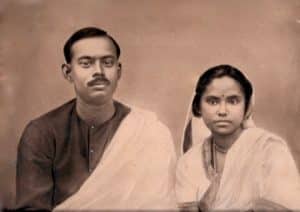
That was the night of August 14, 1946. The next day, Calcutta turned into a killing ground overrun by brutes. Communal riots tore the city apart. From our rooftop we watched houses burning all around and the cries of terrified people. We were very frightened. Nobody could sleep. Muslims killed Hindus and Hindus killed Muslims. For three days we heard nothing from our father but could see fires burning in the neighbourhood of the hostel where we had left him. Later we heard that a few hours after we had left, about 4 in the morning, a rowdy mob of Muslims came to surround the hostel. The students took refuge in our apartment with my father because it seemed comparatively safe and the crowd did not try to break in because they were not sure how many people there were and how well armed.
The situation became very tense. There were no phones, so they could not call for help. There were some biscuits, bread, jam and few snacks in our pantry, on which my father and the students survived for three days. But they soon run out of food and became desperate. On the morning of the fourth day, the students who were watching the mob through the window shutters spotted a police truck and decided to rush out as a group. Those 30, perhaps 40 students did so, and stopped the truck. The mob kept away and the truck driver told the students to get their valuables while he waited for them. Six students went back to their rooms but just then the mob rushed at the truck and the driver was forced to drive away with the other students and my father. They were taken to a police station where they took shelter. My father eventually got hold of another truck and a police detachment, with whom he went back to the hostel. The mob was still there but fled upon seeing them. On entering the hostel my father found three students lying severely wounded. One died within minutes on his lap. There were three other students who were already dead. One body had been chopped into pieces, taken away on a rickshaw, and the killers were about to do the same with the others when my father arrived with the police force. Two severely wounded students with their bellies slit were taken to hospital where they survived to tell their tales. My father returned to my mother at my cousin’s house and to safety. But he had nightmares every night and could not sleep for months. Eventually Mahatma Gandhij came to Calcutta to try and calm the people down by vowing to fast to death until the rioting stopped. I do not recall what happened then but when Pūjā vacations 1 started in early October we went to our Bhagalpur home to recover in peace from the terrible events we had gone through.
However, an even greater blow was awaiting us. Durgā Pūjā was held, as it was every year, in our ancestral home in the village of Karpara in the district of Noakhali in East Bengal. Two of my uncles lived there and another uncle, who practiced Law in Noakhali town, went there with his family for the occasion. So did two cousins who lived with us in Calcutta but went to visit their parents and attend the pūjā. Almost my entire paternal family was there except for us and an uncle and his family who lived in Patna. Durgā Pūjā in Bhagalpur, used to be celebrated next to our house and used to be lot of fun and so it was that year too.
Five days after Durgā Pūjā was Lakṣmī Pūjā -nothing but peace in the air. Two days after Lakṣmī Pūjā, we were at breakfast at home. An older cousin of ours was a college professor in Bhagalpur and they were with us that day. That morning when his wife opened the newspaper, she got up in a hurry and left the table abruptly. I do not remember exactly what happened then, but I do remember seeing my father and my cousin sitting there stone-faced with the newspaper open before them. We looked at the front page and saw two sentences printed in large type:
Zamindar Rajendra Lal Roy Choudhury killed with his entire family.
The family home burnt down.
Rajendra Lal Roy Choudhry was my father’s elder brother and cousin visiting us was his eldest son. This uncle was politically very active and was the president of Hindu Mahasabha 2 of that district. He had serious disagreements with Huseyn Shahid Suhrawardy, then Chief minister of Bengal and an influential member of the Muslim League. As his opponent my uncle Rajendra Lal was an obvious target but the murderous plot that a local Muslim League politician had hatched did not spare my uncles, cousins, other family members, and dependents who were present at home. I cannot speak form personal experience of what happened on that ill-fated day after Lakṣmī Pūjā but have to relate what I later heard many times from the few cousins who survived the massacre.
On the morning after Lakṣmī Pūjā, a mob of some 300 Muslims—all strangers to our village—came and set fire to the family home and killed the males of the family, numbering 29 in all. The women had taken shelter on the roof of the building and were spared. Three male cousins who lived in the village and knew its byways survived by hiding in paddy fields and the woods nearby. Two cousins visiting from Calcutta did not know where to hide and were killed brutally. One cousin, then ten years old, was saved by the manager of the estate who tied him to a high branch of a tree, hidden by leaves. No harm was done to the women. When the mob got hold of my uncle Rajendra Lal they left with him. To this day we do not know when or how he was killed. We did hear later that his head and those of the other murdered men were put in buckets and presented to the local leader who had ordered the massacre. When the mob left, local Muslim neighbours came and rescued the women by laying long tree trunks from the ground to the roof because the stairs had collapsed in the fire.
When the news of the disaster reached us in Bhagalpur, my father immediately left for Calcutta so that he could go to Noakhali with Gandhiji in search of the surviving family members. As far as I remember, a cousin of ours who was then living in Calcutta and had lost his father and brother accompanied them. My father returned to Bhagalpur to make arrangements for the survivors, still a large number, who were to arrive from Noakhali. They had nowhere else to go. Finally, one evening, almost fifty women and children arrived at our Bhagalpur home. Horse-drawn carriages stopped in front of our house and our relatives alighted, their bitter wailing ripping the air. Of them, 22 women had lost their husbands, some their sons as well. Some were weeping and some were frozen by grief beyond expression or sound.
Bhagalpur’s atmosphere became instantly charged with horror, anger and hatred. The next morning some innocent tailors and labourers who lived in the neighbourhood, whose only fault was that they were Muslim, were dragged in front of our house and brutally slaughtered before my own eyes. I was standing in the front veranda on our second floor, when this happened and before I could understand anything or my mother could drag me inside, the work of bloody revenge was done. It sparked off the communal riots of 1946 in Bhagalpur.
The bodies of our slaughtered relatives could not be recovered from our village home but funerals had to be performed. Altogether 29 effigies were made with consecrated grass and cremated ritually. Our entire extended family lived with us for six months. There was little food or clothing and we lived on plain rice and lentils, while my mother sewed basic clothing for everybody, with help from my eldest sister. Eventually my father went back to Calcutta to resume his teaching as did my eldest sister to resume college. The rest of us stayed on in Bhagalpur for a few more months, with my mother taking care of all of us, before we could join my father in Calcutta. Our other family members gradually found places to settle down in Bihar and West Bengal, and perhaps found peace as well.
In 1950 tragedy struck again and this time the blow fell upon the family of my mother’ elder sister who lived with her family in Dhaka in what is now Bangladesh. My uncle was a Judge in the Dhaka High Court. He died in 1949 of natural causes. Dhaka had been relatively peaceful during the 1946 riot but was ravaged by communal conflict in 1950, in which my aunt’s 24 year old grandson was killed. My aunt and her family fled to Calcutta to live with us and stayed for 3 years until her adult children were settled professionally.
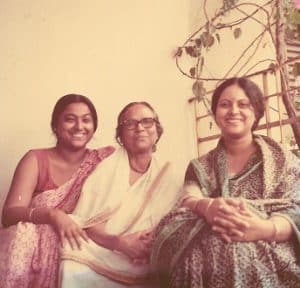
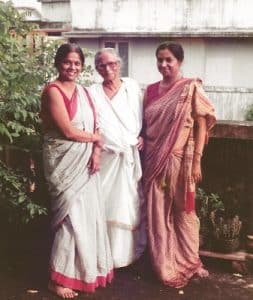
Are these memories worth saving? Some might say that such wounds can never be healed. And it is true that for years I could not face them. Yet I have been able eventually to write down these memories of inhumanity, and thinking back, I realize that through the years my reaction—as indeed the reaction of my parents and sisters—has evolved beyond grief and anger of those horror-filled days into a bewildering sadness at knowing that human beings can so dehumanize themselves. My emotional situation is no different from that of my father’s seventy years ago when he directly faced his own death, and his daily remembrance of what had happened to his beloved brothers and nephews. He could talk about it only to his family and intimate friends but never publicly. The wound was too raw even though he kept his balance as a historian and a scholar of Islam. Perhaps it is his legacy that has strengthened me to speak of my memories openly and across the communal divide, certainly with sadness but no hatred.
Mandakranta Bose, D.Phil. (Oxon.), FRAS, FRSC is a Senior Fellow at the OxfordCentre for Hindu Studies, Professor Emerita and Former Director, Centre for Indiaand South Asia Research, Institute of Asian Research at the University of BritishColumbia. She studied Sanskrit at Sanskrit College, Calcutta, ComparativeLiterature at the University of British Columbia, and holds a D.Phil. in Sanskritfrom Oxford University. Her many fields of interest include dance and drama in theearly Sanskritic tradition, women’s location within the Hindu ethical and culturalworld, the Rāmāyaṇa, medieval Bengali poetry, and Rabindranath Tagore. In allthese areas Professor Bose has published numerous books and articles.
Some of hermost recent publications include:
Women in the Hindu World. San Rafael, CA: Oxford Centre for Hindu Studiesand Mandala, 2022. Forthcoming.
The Goddess, ed. Mandakranta Bose, a volume of the Oxford History ofHinduism. Oxford: Oxford University Press, 2018.
The Ramayana in Bengali Folk Paintings. New Delhi: Niyogi Books, 2017.
A Woman’s Rāmāyaṇa: Candrāvati’s Bengali Epic. Eds. Mandakranta Bose &Sarika Priyadarshini Bose. Translated with introduction and annotations.London & New York: Routledge, 2013.
Women in the Hindu Tradition: Rules, Roles and Exceptions. London & New York:Routledge, 2010.
Saṅgītanārāyaṇa: A Critical Edition with translation. Kalamulasastra series, vols.53 & 54, pp. lii, 972. Delhi: Indira Gandhi National Centre for the Arts, &Motilal Banarsidass, 2009.
Professor Bose lives in Vancouver, Canada.
Footnotes
- The autumnal break in Bengal for the annual worship of Durga in Bengal
- A right wing Hindu nationalist party started in 1915
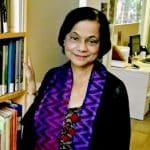
Rani sureshwari Devi is there family members is it urgent
Rani sureshwari Devi is there family members